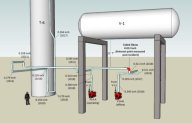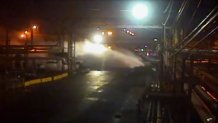Who knows what exactly the worker inside a pickup truck was thinking? He had just pulled up to find a creepy vapor cloud spewing toward him at the South Philadelphia gas refinery early June 21.
But it's pretty clear by how fast he pumped the brakes and threw the truck in reverse that he didn't like what he saw.
Video from surveillance cameras inside the Philadelphia Energy Solutions facility (seen above) show the poisonous gas cloud that soon erupted into a fireball and ignited an inferno that took days to control and months to contain.
The cameras also showed from yards away the third and largest blast at 4:22 in the morning that rocked neighborhoods from South Philadelphia to South Jersey, and eventually led to the shutdown of the East Coast's largest gas-processing plant.
NBC10 obtained the video from the U.S. Chemical Safety Board, which on Wednesday released a report that determined the entire disaster was due to the failure of a decades-old pipe that was badly in need of replacement.

The 26-minute video from two cameras was given to the federal agency by PES, the refinery owner that has since declared bankruptcy. The facility never opened again after the June explosions.
In the first moments of the video, a truck arrives to find the ominous, growing vapor cloud, described aptly by federaly investigators as "ground-hugging."
In what could be described as something out of a Stephen King novel, the cloud grows in size and strength before erupting in fire.
During the next 20 minutes, the flames grow despite water from fire hoses and at least one man can be seen running within feet of the huge flames.
Local
Breaking news and the stories that matter to your neighborhood.
Three massive drums containing thousands of pounds of flammable gases — and the containers themselves each weighing multiple tons — were sent airborne by the blasts.
The investigation is continuing into why an elbow joint in the pipe system of an alkylation unit at the refinery was never replaced. It is believed to have been installed in 1973. At the time of the disaster, it had degraded to 7 percent of the thickness that normally requires replacement, investigators said.




